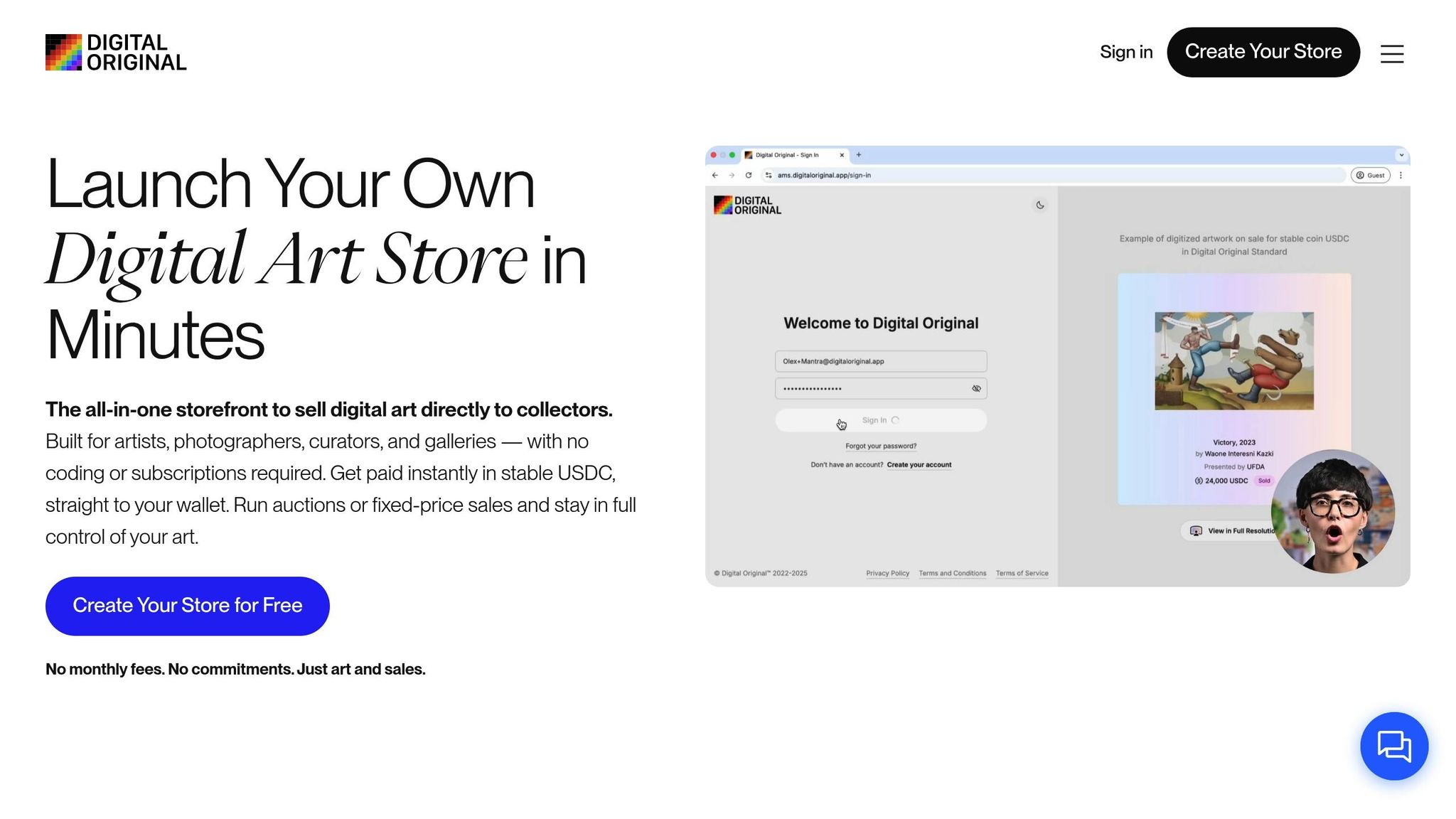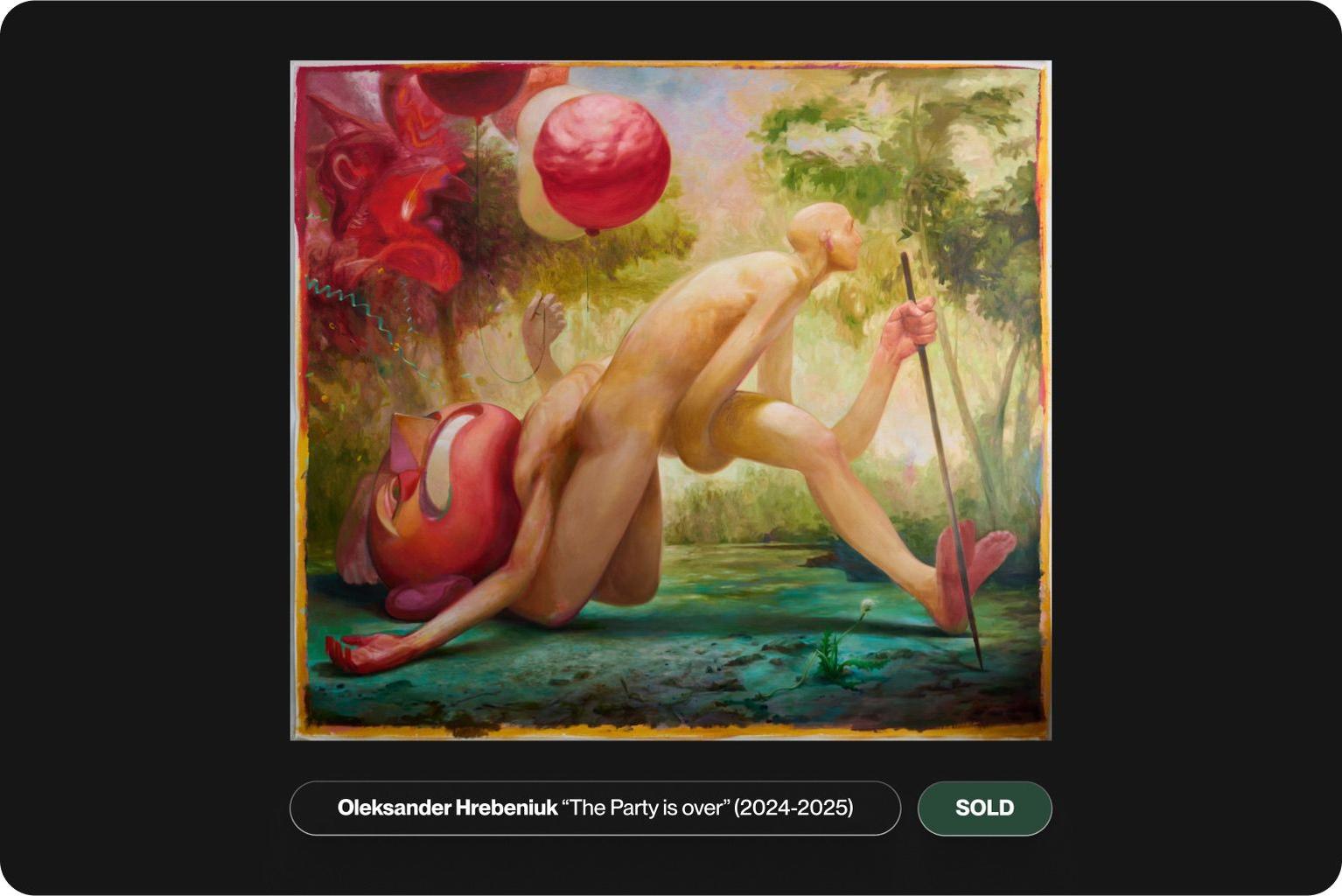Smart Contracts in Fixed-Price Art Sales
Smart contracts are changing how digital art is sold by automating payments and ownership transfers. These blockchain-based programs remove intermediaries, speed up transactions, and ensure secure, tamper-proof records. Here's what you need to know:
- What They Do: Smart contracts automatically handle payments and ownership transfers when conditions are met.
- Fixed-Price Sales: Artists set a non-negotiable price for their work, simplifying transactions for buyers and sellers.
- Key Benefits: Instant payments, lower fees, transparent transaction history, and automatic royalty distribution for artists.
- Challenges: Technical complexity, high blockchain fees during peak times, and legal uncertainties in some regions.
Platforms like Digital Original make it easier for artists to leverage smart contracts without technical expertise. They offer tools for minting NFTs, setting prices, and managing royalties, all while ensuring smooth, secure transactions in stablecoins like USDC.
Smart contracts streamline the process, making digital art sales faster, safer, and more efficient for both artists and collectors.
How to Sell and Mint Your NFT Collection with Smart Contract and Minting Page (NO CODE)
How Smart Contracts Handle Fixed-Price Digital Art Sales
Smart contracts take charge of every step in a fixed-price digital art sale, ensuring seamless and consistent execution for all parties involved.
When an artist lists their digital artwork at a fixed price, the smart contract handles everything - escrow, payment processing, and ownership registration. It securely stores all the essential details, like the artwork's price, the artist's wallet address, and the terms of the sale. Let’s break down how payment processing, NFT creation, and transaction fees work in this system.
Payment Processing and Ownership Transfer
The magic of smart contracts lies in their ability to process payments and transfer ownership in a single, secure transaction. This "all-or-nothing" approach ensures that every step happens together - no risk of partial transactions where money changes hands without updating ownership.
When a buyer clicks "buy", the smart contract first checks if they have enough funds. If everything checks out, the contract instantly debits the buyer’s account, credits the artist’s wallet, and transfers ownership of the digital artwork. This instant settlement means collectors can immediately display, transfer, or resell their new piece without the delays common in traditional payment systems.
Platforms like Digital Original enhance this process by offering instant USDC payouts. This means artists receive their earnings in a stable cryptocurrency pegged to the US Dollar, avoiding the unpredictability of crypto price swings while still benefiting from blockchain’s speed and efficiency.
NFT Creation and Data Storage
Smart contracts don’t just handle payments - they also secure the artwork’s digital identity. Each piece of art gets its own unique Non-Fungible Token (NFT), which acts as a permanent digital certificate confirming authenticity and ownership. This NFT includes key information like the artist’s verified identity, the creation date, artwork details, and a link to the digital file.
While the blockchain ensures this data is tamper-proof, the artwork’s visual files are typically stored using distributed storage systems. The NFT itself contains a cryptographic hash, which guarantees the integrity of the linked file. This setup strikes a balance between keeping records permanent and avoiding the technical challenges of storing large files directly on the blockchain.
Each time the artwork changes hands, the smart contract updates the ownership record and adds a new entry to the transaction history. This creates a transparent and unbroken record of ownership, boosting the artwork’s credibility and value over time.
Transaction Fees and Cost Structure
Every blockchain transaction comes with gas fees, which cover the cost of executing smart contract operations. These fees vary depending on network demand, and smart contracts calculate the exact amount needed at the time of the transaction to ensure it goes through smoothly.
Platforms like Digital Original structure fees in a way that’s fair and accessible. They charge a fee of 5-15% per sale and operate on a "no sales, no fees" model, meaning artists only pay fees when their work sells. This approach makes it easier for new artists to enter the space while also supporting the platform’s maintenance.
Smart contracts also handle fee distribution automatically. They split payments - covering platform fees, gas fees, and royalties - according to pre-set percentages. These payments are sent to the respective wallets at the same time ownership is transferred. This automated process simplifies transactions and highlights how smart contracts make digital art sales efficient and transparent.
Key Elements of Art Sale Smart Contracts
Smart contracts have transformed digital art sales by offering a secure and transparent way to manage transactions. These contracts incorporate several key components that handle everything from identifying the artwork to distributing payments, ensuring both artists and collectors benefit from clear, reliable records.
Token Identity and Artwork Information
Every digital artwork is assigned a unique token ID, essentially serving as its digital fingerprint. This token is linked to standardized metadata, which includes details like the artwork's title, description, creation date, file format, and the artist's wallet address. All of this information is stored on the blockchain, making it both accessible and verifiable for the lifetime of the artwork.
Additionally, the metadata includes a cryptographic hash of the original artwork file, ensuring its authenticity and protecting against tampering. While the core metadata is stored on the blockchain, supplementary details - such as high-resolution images or extended artist statements - are typically saved on distributed file systems, with links back to the blockchain for easy access.
Royalty Systems and Payment Distribution
Beyond identifying the artwork, smart contracts also streamline revenue distribution. They are programmed with royalty mechanisms that automatically allocate a fixed percentage of future sales to the artist. For instance, if a 5% royalty is set during the minting process, the smart contract will automatically calculate and transfer that amount to the artist whenever the artwork is resold, while distributing the remaining funds to the seller.
These contracts can also handle more complex payment scenarios. For example, royalties can be divided between multiple parties, such as collaborating artists or galleries, based on pre-defined rules. Once these rules are established during the contract's creation, they execute automatically with every transaction, ensuring a seamless process.
Ownership History and Rights Management
Smart contracts maintain an immutable record of ownership changes, creating a detailed provenance trail. This record includes timestamps, transaction amounts, and wallet addresses for each transfer, adding credibility to the artwork by providing a verifiable history.
It’s important to note that owning an NFT does not automatically mean owning the copyright to the artwork. Smart contracts typically track ownership of the digital token but do not transfer copyright unless explicitly programmed to do so. In most cases, buyers gain the right to display and resell the NFT, while the artist retains commercial copyright.
Smart contracts can also encode specific usage rights. For example, they might permit the NFT owner to use the artwork as a profile picture or in virtual galleries, or they could restrict usage to personal viewing only. These conditions are embedded in the contract and are enforced automatically, ensuring a clear and tamper-proof record of ownership and rights.
Together, these elements create a comprehensive framework that supports secure, efficient, and transparent transactions, making smart contracts a cornerstone of modern digital art sales.
sbb-itb-4e84554
Implementation Guide for Artists and Collectors
Diving into smart contracts for fixed-price art sales might sound intimidating, but it doesn’t require technical skills. Today, platforms handle the blockchain heavy lifting, letting artists and collectors focus on transactions and pricing strategies.
Creating Fixed-Price Sales
Start by connecting your digital wallet - like MetaMask - to authenticate and receive payments. Then, upload your artwork and fill in the essential details, including the title, description, and usage rights.
Set a fixed price in your chosen cryptocurrency or stablecoin. Many artists prefer USDC because its value doesn’t fluctuate like other cryptocurrencies. You’ll also configure royalty percentages during this step. These royalties are locked into the smart contract and automatically enforced during every resale.
The next step is minting your NFT. This process creates the token and deploys the smart contract at the same time. It typically takes just a few minutes and requires paying a small gas fee to the blockchain network. Once the contract is live, you’ll receive confirmation, and your artwork will be available for purchase.
After setting your fixed-price sale parameters, it’s time to use a platform that simplifies the blockchain process.
Working with Digital Original Platform

Digital Original offers a user-friendly storefront equipped with tools for fixed-price sales, including instant USDC payouts and performance-based fees.
Here’s how it works: when you upload your artwork and set a price, the platform automatically generates the necessary smart contracts. These contracts come with features like verified ownership transfer, automatic royalty distribution, and instant payment processing.
Payments are made in stable, dollar-denominated amounts right after a sale, so artists don’t have to worry about cryptocurrency volatility. Meanwhile, the platform handles all blockchain operations in the background, making the process seamless for artists who want the benefits of blockchain without the technical hassle.
Digital Original also gives artists control through its storefront management system. You can manage visibility, set private access for specific collectors, and organize multiple artworks - all from a single dashboard. Plus, the platform is optimized for both mobile and desktop, ensuring collectors have a smooth browsing and purchasing experience.
This combination of smart contracts and an easy-to-use interface allows artists to focus on their creativity while enjoying the technical perks of blockchain.
Guidelines for Artists and Collectors
Once your setup is complete, follow these tips to maximize your art sales and ensure secure transactions.
For artists, pricing should reflect both the value of your work and the market. Research similar pieces and consider factors like your existing collector base, the uniqueness of your art, and the complexity of the medium. Many digital artists start with moderate pricing and adjust based on demand.
File preparation is another key step. Use high-resolution formats for long-term value and keep your original files separate from those uploaded to platforms. You might also want to create multiple versions - a high-quality file for the NFT and smaller, compressed files for previews.
Adding detailed information to your NFT can boost its appeal. Include artist statements, a description of your creative process, and any relevant background in the smart contract metadata. This documentation becomes part of the NFT’s permanent record and can enhance its value over time.
For collectors, verification is crucial. Always confirm that the smart contract address matches the official listing and that the artist’s wallet address is legitimate. Many artists verify their identities on social media or official websites, offering an extra layer of authenticity.
Understand what rights you’re buying. Most NFTs include ownership of the token and basic display rights, but not commercial copyright. Always review the terms in the smart contract or platform documentation to know exactly what’s included.
Lastly, your choice of payment method matters. Stablecoins like USDC are often preferred for their price stability and quicker settlement times. However, remember to account for network fees when budgeting for a purchase.
Both artists and collectors should keep in mind that blockchain transactions are permanent. Once a smart contract is deployed, it can’t be easily modified. This makes careful review essential before finalizing any sale or purchase. While this immutability adds security, it also demands attention to detail upfront.
Benefits and Limitations of Smart Contract Art Sales
Smart contracts bring notable advantages to fixed-price digital art transactions, but they also come with challenges that both artists and collectors should weigh carefully.
Main Benefits
Automated transactions
Smart contracts streamline the process by automating ownership transfers and payments, eliminating the need for intermediaries. This automation not only speeds up transactions but also opens the door to benefits like global accessibility and built-in royalties.
Global market access
Operating around the clock and across time zones, smart contracts make it possible for artists to connect with buyers worldwide, significantly broadening their audience.
Built-in royalties
Artists can program royalties - typically ranging from 5% to 15% - into the smart contract. This ensures they earn a percentage from every future resale of their work, creating a steady revenue stream beyond the initial sale.
Reduced costs
By cutting out middlemen, smart contracts lower costs for both artists and collectors. The streamlined process improves efficiency and reduces the financial burden typically associated with traditional sales channels.
Provenance transparency
Every transaction is permanently recorded on the blockchain, creating a clear and tamper-proof ownership history. This transparency helps verify authenticity and can potentially boost the value of the artwork over time.
Current Limitations
Despite these benefits, smart contracts come with their own set of hurdles that can’t be ignored.
Technical complexity
Writing secure smart contracts requires advanced programming knowledge, often using languages like Solidity. Even small coding mistakes can lead to significant financial losses, leaving artists and collectors dependent on skilled developers to ensure safety.
Immutability risks
Once deployed, a smart contract can’t be easily altered. This means that any errors in the code are permanent, and fixing major issues often requires drastic measures, like initiating a hard fork of the blockchain.
Legal uncertainty
The legal status of smart contracts is still a gray area in many regions. While a few U.S. states recognize them as enforceable, most jurisdictions don’t, which complicates matters like dispute resolution, taxation, and copyright enforcement.
Scalability issues
When blockchain networks experience high demand, especially those relying on proof-of-work, congestion can lead to delays and increased fees. This can make small-scale art sales less practical during peak times.
Limited adaptability
Smart contracts operate under strict, predefined rules. Changing business requirements often means deploying an entirely new contract, which can be time-consuming and costly. Additionally, their automated nature may not always allow for the flexibility that some real-world situations demand.
For artists and collectors, understanding these pros and cons is crucial when deciding if smart contract-based sales are the right fit for their goals and technical know-how.
Conclusion: Smart Contracts Simplify Fixed-Price Art Sales
Smart contracts take the hassle out of fixed-price art transactions by automatically enforcing agreed terms without the need for intermediaries or delays. As Cem Dilmegani explains, these self-executing contracts not only simplify NFT management but also ensure secure and seamless transfers.
By removing middlemen, smart contracts create transparent, unchangeable records and guarantee ongoing royalty payments for artists - all through automation. This approach benefits both artists and collectors by ensuring smooth, barrier-free transactions.
For artists, the advantages are clear: instant payments, easy NFT minting, automatic ownership transfers, and royalty payouts without extra effort.
Collectors, on the other hand, gain confidence through verified authenticity and secure, tamper-proof ownership transfers, fostering trust in the digital art space.
Platforms like Digital Original make the process even easier by offering an intuitive interface that handles blockchain complexities, allowing artists to conduct fixed-price sales effortlessly and receive instant USDC payouts.
In short, smart contracts are transforming the way art is sold. By automating tasks that once required multiple intermediaries, they make fixed-price art transactions quicker, more transparent, and efficient for everyone involved.
FAQs
How do smart contracts make fixed-price art sales secure and reliable?
Smart contracts leverage blockchain technology to facilitate secure and tamper-resistant agreements for fixed-price art sales. These digital contracts are self-executing, meaning they automatically enforce the terms of a deal, ensuring payments are processed and ownership is transferred exactly as agreed.
Each transaction is permanently recorded on a blockchain ledger, which cannot be altered or tampered with. This safeguards both artists and buyers, while also promoting trust by ensuring every sale is transparent and accountable.
What legal issues might artists encounter when using smart contracts to sell digital art?
Artists leveraging smart contracts for digital art sales might encounter legal hurdles, particularly around enforceability. Not every jurisdiction views smart contracts as legally binding agreements, which can complicate matters. On top of that, copyright and intellectual property conflicts can emerge, as smart contracts don’t inherently enforce copyright protections or ownership rights.
To sidestep these challenges, it’s crucial for artists to ensure their contracts are meticulously written. Seeking advice from legal professionals with expertise in blockchain technology and digital art can provide added security and clarity.
What are the benefits of using stablecoins like USDC for artists in smart contract art sales?
Using stablecoins such as USDC brings notable benefits to artists involved in smart contract-based art sales. One major advantage is the ability to process quick and affordable transactions, allowing artists to receive payments almost immediately without incurring hefty fees. Another key benefit lies in their connection to the US dollar, which ensures price stability. This minimizes the risk of unpredictable cryptocurrency price swings, helping artists safeguard their earnings and offer consistent pricing for collectors. In essence, stablecoins simplify the payment process while boosting financial reliability for both creators and buyers.





